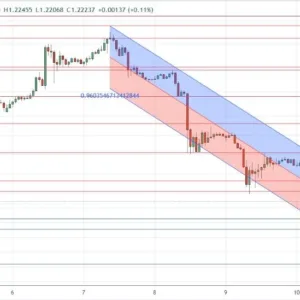- Gold’s gains appear dubious, and could sucker-punch bulls
- India’s foreign exchange reserves on a decline for over 3 months
- AUD/USD Forecast: Aussie Bounces Back as Dollar Bulls Fade
- USD/MYR Forex Signal 08/01: US Dollar Plunges (Chart)
- China Introduces New Forex Rules To Tighten Crypto Oversight and Target Illegal Cross-Border Transactions
Trading Forex can be as unpredictable as Manchester’s famously changeable weather.
Bạn đang xem: Do currency markets have a ‘weather pattern’?
One minute, it’s plain sailing; the next, you’re riding on rough waves.
But what if the currency markets, like Manchester’s seasons, had recurring patterns you could anticipate?
This means recurring trends, or predictable “weather patterns” in trading, normally related to specific times of the year.
What is seasonality in Forex?
Seasonality in Forex is patterns or trends that happen at certain periodic events of a year.
These aren’t coincidental, they are more often than not tied to economic cycles, world events, and even psychological peculiarities among traders.
A good example could be when some currencies strengthen at the beginning of the year in JM as a result of new fiscal policies or weaken during summer months when volumes dry out.
It’s like how businesses know they’ll sell more ice cream in July and more jackets in December.
The thing is, just because there was a pattern in the past doesn’t mean it’s going to crop up every year. Markets are nuts.
What causes seasonality?
Xem thêm : AUD/USD Outlook: Aussie Rides High on China’s Stimulus Efforts
The reasons for seasonality in Forex are often tied to bigger global and local factors such as:
- Economic reports: Scheduled data releases – like employment rates, GDP or inflation – can move currencies. In the UK these reports are big for the pound.
- Holidays and vacations: Trading slows down during summer or year end holidays including in Manchester as businesses and individuals take a break. This low volume can cause unexpected spikes or tighter ranges.
- Corporate activity: Manchester is a business hub so year end adjustments or large currency conversions can cause fluctuations in the pound’s demand.
Seasonality reflects these trends but is never guaranteed – just like Manchester weather.
Seasonal patterns
Let’s look at some seasonal patterns that traders connected to Manchester’s economy might see:
- The January effect: The US dollar is more volatile in January due to portfolio rebalancing and new fiscal policies. For UK based traders this can be a time to watch the pound against major pairs like USD/GBP.
- Summer slowdown: June to August sees lower trading volumes as global markets go quiet. But Manchester’s tourism, events and hospitality sectors keep the local economy buzzing.
- Year end wobbles: December sees volatility as traders close positions and companies settle their books. In Manchester retail and holiday shopping adds to the mix.
Seasonal Trends in Key Currencies
| Month | Currency Behavior | Reason |
| January | USD shows high volatility | Portfolio rebalancing, new fiscal policies |
| June-August | EUR/USD lower trading volume | Summer vacations |
| December | GBP, USD often volatile | Year-end tax adjustments, holiday spending |
How to Use Seasonality in Your Trading
Seasonality can be a powerful tool for Forex traders when used in conjunction with a city’s economic cycles. Here’s how to use seasonality in your trading.
Research historical data
Firstly, study the historical trends of the currency pairs you trade most.
Look back 5-10 years to see what patterns emerge at certain times of the year.
For example:
- Does the pound weaken in the summer?
- Is there a January spike in GBP/USD?
These patterns if consistent can help you predict and fine tune.
Combine seasonality with technical analysis
Seasonality on its own is not a failsafe – it works best when combined with other forms of analysis.
Technical indicators can back up or reinforce seasonal insights giving you a better overall view of the market.
For example:
- If historical data shows a summer slowdown in GBP/USD and technical analysis shows consolidation, this alignment can give you more conviction in your trade.
Xem thêm : GBP/USD Forex Signal Today 06/01: Rising Firmly (Chart)
By using seasonality as a secondary factor you reduce the risk of relying on it alone.
Trade at the right time
Seasonality can also help you time your entries and exits.
- If you know the pound strengthens in January, get in early.
- Conversely if historical data shows a decline, avoid longs or look for shorts.
This timing can help you trade better and more profitable.
Is seasonality reliable?
The truth is, seasonality is not bulletproof. It’s a guide, not a rulebook. Economic conditions, geopolitical events, or central bank decisions can easily break patterns.
For example, the COVID-19 pandemic threw seasonal trends out the window. Global uncertainty led to unpredictable market movements.
So think of seasonality as one piece of the puzzle. Don’t rely on it alone but don’t ignore it either.
Pros and cons of using seasonality in Forex
Let’s weigh the good and the bad.
Pros
- It brings some depth to your technical analysis since it connects you to the latest relevant literature.
- It is useful in providing you with an early warning on trends.
- Is useful in long term planning.
Cons
- Not always reliable.
- Can be overpowered by events.
Final thoughts
When used together with proper research and a good trading plan it can turn out to be very useful.
But do not let it be the dictator of your strategy.
It would be great to get more insight from it, but always take into consideration the broader view: the headlines, breaking news, and sudden changes in the world.
But, like the weather, the Forex can sometimes just blindside you when you least expect it.
Nguồn: https://cumlaude.fun
Danh mục: News






